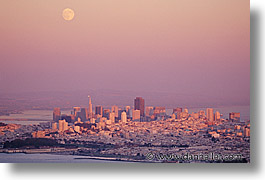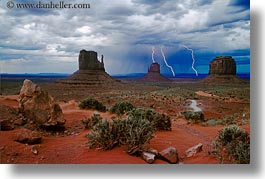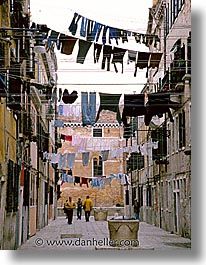|
Markers indicate locations for photos on this page.
Accuracy responsibility of Google Maps
Google Map Goes Here
If you see this text, the map is still loading (or there's an error). |
At one time or another, each of us has had exactly the same feeling. It's a tempting prospect to just shoot photos of beautiful landscapes or cute pets or children, and then sell them as postcards, greeting cards, posters or calendars. But, as illustrated by the above email, it's hard to know how to get started, or if it's even possible. It's not so much a question of whether it's possible, but weighing the pros and cons on two different strategies: whether to find someone else to do it, or do it yourself. The crux of the problem lies in that the costs for producing products like these are not much less than what people will pay for them. In order to make money, you need to sell a lot of them. Now, if you're thinking to yourself—as I did at one time:
Ok, that's fine. But the concern isn't about making money, it's potentially losing it. Reminds me of a quote from one of my favorite stock market investors:
What major airlines and small-priced commodity products have in common
is that they require a lot of investment just to keep from losing your
investment. And you can't just do it in small doses; it's like feeding an
elephant. You can't decide to just feed it "a little bit" because you don't
want to have a large animal in the house. You either sign up for the big
animal, or you decide to get a dog. This effort is going to require time
and attention, or you'll end up with a large mound of postcards in your
garage. However, it can be done, like anything else, if you go about
it intelligently. So, don't let me talk you out of it... yet.
Getting back to basics, the secret to making a postcard effort succeed is one word: distribution. The cost of making postcards or calendars is close enough to the same price as what people will pay, that the profit margins (after you factor in unrelated costs) are slim. The only way to reduce overall costs "per unit" is to print a higher volume of units. And that's where distribution comes in. That is, you need to move this product through a distribution channel—a set of outlets (sales reps or stores) willing to take your product on an ongoing basis. This requires keeping in touch with them, checking on inventory, filling empty slots with new products, determining which products aren't selling, getting clients to pay their bills, apologizing for missing last Tuesday's appointment, and acknowledging that your idea for last year's Christmas card, "Santa Gets Sued," might not have been a great idea.
Let me be clear at this point: some people find this process very enjoyable.
I'm not being satirical; it's true. And there's no shame in it. This is a
very people-intensive business, and those who thrive best are those who
love engaging socially. As long as you are clear in your goals and
ambitions, achieving them is easier and more enjoyable, and this example
is a perfect one. If you're not eager to do all this legwork, the
objective is to find other people who'll do it for you. So, as you
discover your tolerance for different things, you'll vacillate between
steps 1 and 2 till you find your groove.
Whether you do it yourself, or you go to another company to sell your work, there are two main barriers to entry in the postcard/calendar market that you'll immediately run into.
First, there are millions of people trying the same thing. Professional photographers aren't the only ones that take great pictures. Amateurs have really good ones too, and although they may not take the business as seriously as the pros, their sheer numbers make them formidable competition. Photo buyers, whether they are publishers or small gift shop owners, have to sift through so much material, that it's hard to get to the good stuff, let alone yours. The irony of all this (or perhaps the reason for it) is that despite the quantity of images they get, there seems to be a large quantity of poor material for sale. This explains the next barrier:
Ok, it's not quite that depressing. When pressed, the editor also acknowledged that it is great to find something new and unique, but it's not a goal that they go out of their way to achieve. Cards that don't sell can drag on profits quickly. Working with shop owners is much easier, because they don't get approached quite as often by photographers. They will often take more time to consider your work, but your competition is the same, although from a different source: the postcard companies you tried to approach before. Shop owners order batches of products in bulk from the big suppliers, so the same principle applies. Hence, the reason why the grass always appears greener on the other side: it sometimes seems easier to get into a store if you go through the publishing channels. The one advantage you may have with the shop owner is: local color. Chances are slim that major, nationwide card companies are going to provide a whole rack of scenics from your local landscape (unless you live in a major national park, or heavily touristy city). This may be a potential "in" for handling it yourself.
Now that we've addressed the barriers to entry, let's discuss the two
options more closely. First, we'll address approaching product companies,
then we'll discuss doing it yourself.
Simple, just as I said! However, I didn't say you'd be successful at it. It's not that there's a "better" way; this is one of many, but almost identical methods: you have to search who's who, and then contact them. The hurdle to clear during this phase is the photo editor. (If it's a larger company, it's the assistant photo editor.) This person's job is like the goalie in a soccer game: to keep the photographers out of the net. Before you even get to other questions, you'll probably be told that their list of photographers is long, but that they are always interested in seeing fresh new stuff, so you should send it in. "However," the editor continues, "your chances are limited." You'll always get encouragement to send material, but discouragement that anything will come of it. Here's where you can turn this to your advantage: ask what percentage of total submissions they accept? How many images do they usually take from a photographer? How often do they use the same photographer's work? This is all to help you learn what it's like on the other side of the fence and to set your expectations properly. If you're getting good, candid feedback, find out what the real pay scales are like so you can see just what it is you're missing... or not? What are the payments like? What kind of returns are their "best" photographers get? And what about the "average" photographer? Or even you if they were to take even one image a year. (This, with the longer-term sense of what it might be like to be the supplier for a dozen different companies.) If you're still at it, probe further: try to get a characterization of what their typical photographer is like? Are they full-time pros, or average people that send in good shots here and there? At least you want to know who you're up against. If you get vague responses, like "they're all over the map," then you'll see that you're really just playing a lottery game.
Oddly enough, you may find that what you've done is build a small stock photo agency, and your opportunity to get published is much greater if you'd widen your horizons beyond just cards and consumer products. This is why it's very rare to find photographers that sell exclusively to card companies. Most have more generalized photography businesses, where a small percentage of sales happen to go to that sub-segment of the market. Accordingly, most companies that sell these products select from a wide cadre of photographers. I'm a good example of that; I've sold many images to postcard and calendar companies, but they account for a small percent of my overall business, just as I am but one of hundreds of their suppliers. While some photographers have gotten their "in" by approaching such companies, their numbers are a small percentage of those who've tried.
If by the end of this exercise, you feel compelled to continue, you
have a stomach for the business in general, and I'd say you're a prime
candidate to sustain a serious photo business than one simply focusing
on cards. It may be that you start in this area, so I would certainly
not discourage you from attempting it. My dim forecast for success in
this business is a mildly unsettling honesty that must be expressed if
for no other reason than most people who want to do this start out with
unrealistic expectations. The bright side is that those who do have
realistic expectations don't see this characterization as "dim" at all;
they find it refreshingly challenging. If you find it's not for you,
consider:
To keep from losing money, you have to sell enough cards to at least cover the cost of production and other expenses to get them onto store shelves. As it is with these products, the cost goes down as quantity goes up. It actually costs more to produce cards in smaller quantities than what people are willing to pay for them. So, you have to print in higher quantities to get the prices low enough that the retail price brings in money (or keeps you from losing money). This usually translate to about 2,000-3,000 cards. And that's for one individual card. If you're going to sell cards, you have to sell more than one image. To move that many cards, you've got to have at least 25-50 stores selling your work. So, the first thing you need to do is see if there are even enough places that can sell your cards. If you haven't already done so, spend some afternoons going to a few outlet stores in your areas to get an idea of what's out there. What kind of stores sell cards? Gift shops, of course, but also pharmacies, grocery stores, gas stations, etc. The options may be limited or great, depending on where you live. If you're thinking of producing and selling cards strictly online to eliminate the distribution model, start by reading lark-web. (Hint: selling on the web requires getting traffic, which is another kettle of fish all together.)
Greeting cards (4x6 or 5x7) usually sell between $2.00 and $3.50 per card,
depending on variables like size, store location, photo subject, and the
physical materials of the card. Talk to store managers and ask which
cards sell well and which don't. You will invariably hear how they
were initially surprised on the returns, both positive and negative.
(Again, there's no accounting for taste!) You don't want to end up with
a garage full of unsold cards, so you need to go about this intelligently.
The variables in your control are:
See Selling Photography Prints for a discussion on the kinds of issues involved when determining what kind of art sells, but also realize that selling postcards and greeting cards isn't like the art market. In this context, your target audience is the "consumer," as defined in that chapter. As general market data proves over and over, anything seems to sell well to the consumer if you position it, package it and price it right. (There are as many shrugging shoulders on why a product didn't sell well, as there are for those products that did.)
Similarly, there's no point in discussing where you sell your wares
because only you know your local market. At this point, it's a matter
of choosing your business model: which image, which format, and how
you're going to manage production and distribution.
You can usually buy the envelopes at the same place you get the card
stock. Put them all together and you've got a generally salable product.
(Getting them to retailers may require extra packaging, but those are
details that you'll run into as you go through the process.)
Choosing a company include the usual word to the wise: printing and
service varies dramatically, so don't just go with the cheapest provider
you find on the internet. Everyone will send you a sample kit of products
so you can see what yours will look like, so you don't need to shoot in
the dark.
And it gets worse from there: usually, ¼ to ½ of postcard inventory sells "well," leaving the rest to find their way to your next garage sale, where you'll be happy to give them away for $.10/each. If you're thinking that postcards are less expensive, yielding a higher profit at lower costs, it's true, but only marginally. Besides, the math is exactly the same. The cost to make postcards ranges with quality and quantity, but this is a mature business, so I'll just jump to the end for you: The retailer is going to take 50%, leaving you with about the same amount of money it costs to make the darn things in the first place.1 If it isn't entirely obvious, the real key to all this is "volume," which brings us to Economics 101, as taught in every school that isn't found in a communist country: "to make money, you have to produce the product for less than it costs to sell it." As obvious as that is, it's astonishing how many people try to get into the postcard business without thinking through all of the actual costs. Alert readers may be chomping at the bit to say, "just charge another 10% on the retail price, which you share with the retailer, giving you a 5% margin." Oh, if it were that simple. Retail pricing is such a difficult and fickle art that moving ahead with this logic is more likely to produce wider losses than before because you mis-judged what the consumer is willing to pay. To illustrates this point, did you ever wonder why things are priced at $4.99 and not $5? That one little tiny penny has a huge effect on the perception of price and value in the consumer's mind, and despite the fact that we're smart enough to build things like rockets that go to the moon, years of studies have continuously proven that more people will buy a product that costs $4.99, not $5. If that surprises you, then you don't know nearly enough about retail pricing of consumer products. It's not that you can't learn (the easiest way is to copy other existing successful models.) But until then, don't just assume that you can just bump up the price by 10% and suddenly become profitable.
Now, you may be thinking, "Ok, wise-guy: why not print a lot more in
one batch so reduce your costs of manufacturing per unit, yielding a
higher profit margin?" The obvious retort is: that's precisely what
you do when you've figured out exactly which cards will sell well, so
you don't take such a huge bath on your early losses. Try to start
out that way, and you'll lose too much money early on for you (or your
spouse) to have the stomach to keep it going much longer. And this is
what brings us to the next section, where I compound on the theme.
Here's the logic: instead of printing 100s of each card, only print twenty
of them. Instead of $1.50/card, the price goes up to $2.20/card, but
you're buying 80% less. Instead of targeting ten stores, target one or
two. You're buying 80% less again! Your goal isn't to make money, it's
to lose as little as possible so you can figure out which products to
really invest in later. Sure, you are guaranteed to lose money, but
it's a controlled loss, thus, limiting your downside. Now, instead of
your investing $15,000 and potentially losing $10,000, you're only
investing $5,000, and potentially losing $4,000. As a percentage, your
loss is greater, but in real numbers, you've "saved" $6,000 to learn a
very important, and potentially profitable lesson: what products sell
well, and which don't. As you gain this information, you can then widen
your production and distribution to outlets where your success rate is
much better known, and you can get to that coveted position of just refilling
existing stock, at much higher margins.
Hey, remember those calendars and posters I talked you out of earlier? Now may be the time to test those with less-risky images that you know sell well. It takes experimentation to know for sure for your particular photos, your market, and the demographic of your audience, which is why it takes an investment with a potential loss to gain the confidence to make a bigger investment.
Coming full circle to the beginning of this entire thread: if you're
successful at doing this, there's a very high likelihood that some
other, major card publisher would be extremely interested in not only
carrying your work, but even acquiring your business! This is why it's
wise that you set it up right back in Photo Careers.
Independent of all these factors, the real lesson you'll learn is what it's like to be a distributor. If in the end, you figure you might as well work with an established postcard company that already has inroads in doing this exact same exercise, then we've circled the discussion again, but in the opposite direction. The grass is always greener on the other side. Despite the challenges you face in this business, the overlooked benefits are not those of financial return or even time: it's accomplishment. Add to that the feeling of doing something productive with your art, and you find potential value that shouldn't be discounted. Still, to do this without breaking the bank requires starting with good research and thinking ahead.
Click to recommend this page: |
|












